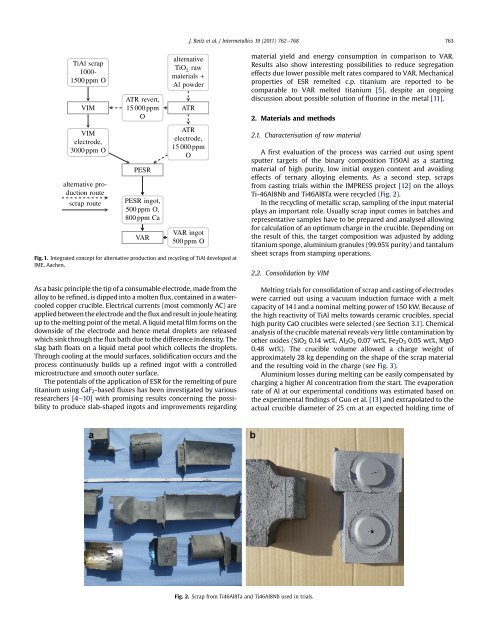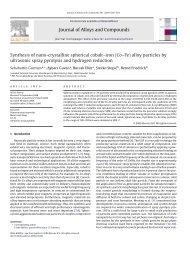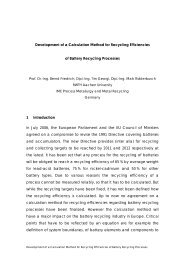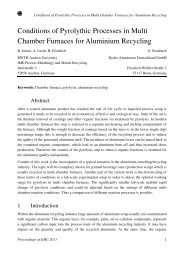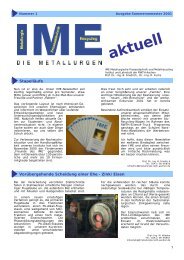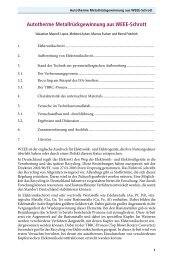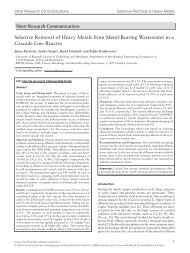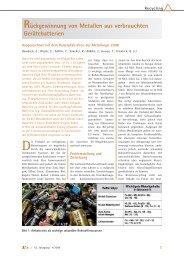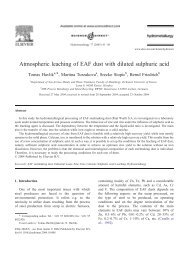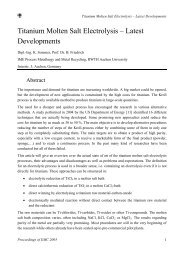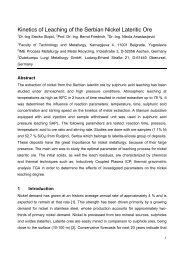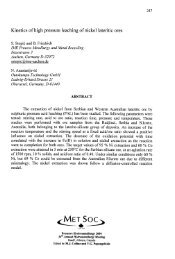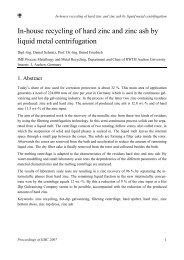Recycling of gamma titanium aluminide scrap from investment ...
Recycling of gamma titanium aluminide scrap from investment ...
Recycling of gamma titanium aluminide scrap from investment ...
Create successful ePaper yourself
Turn your PDF publications into a flip-book with our unique Google optimized e-Paper software.
J. Reitz et al. / Intermetallics 19 (2011) 762e768 763TiAl <strong>scrap</strong>1000-1500 ppm OVIMVIMelectrode,3000 ppm Oalternative productionroute<strong>scrap</strong> routeATR revert,15 000 ppmOPESRPESR ingot,500 ppm O,800 ppm CaVARalternativeTiO 2rawmaterialsAl powderATRATRelectrode,15 000 ppmOVAR ingot500 ppm OFig. 1. Integrated concept for alternative production and recycling <strong>of</strong> TiAl developed atIME, Aachen.As a basic principle the tip <strong>of</strong> a consumable electrode, made <strong>from</strong> thealloy to be refined, is dipped into a molten flux, contained in a watercooledcopper crucible. Electrical currents (most commonly AC) areapplied between the electrode and the flux and result in joule heatingup to the melting point <strong>of</strong> the metal. A liquid metal film forms on thedownside <strong>of</strong> the electrode and hence metal droplets are releasedwhich sink through the flux bath due to the difference in density. Theslag bath floats on a liquid metal pool which collects the droplets.Through cooling at the mould surfaces, solidification occurs and theprocess continuously builds up a refined ingot with a controlledmicrostructure and smooth outer surface.The potentials <strong>of</strong> the application <strong>of</strong> ESR for the remelting <strong>of</strong> pure<strong>titanium</strong> using CaF 2 -based fluxes has been investigated by variousresearchers [4e10] with promising results concerning the possibilityto produce slab-shaped ingots and improvements regardingmaterial yield and energy consumption in comparison to VAR.Results also show interesting possibilities to reduce segregationeffects due lower possible melt rates compared to VAR. Mechanicalproperties <strong>of</strong> ESR remelted c.p. <strong>titanium</strong> are reported to becomparable to VAR melted <strong>titanium</strong> [5], despite an ongoingdiscussion about possible solution <strong>of</strong> fluorine in the metal [11].2. Materials and methods2.1. Characterisation <strong>of</strong> raw materialA first evaluation <strong>of</strong> the process was carried out using spentsputter targets <strong>of</strong> the binary composition Ti50Al as a startingmaterial <strong>of</strong> high purity, low initial oxygen content and avoidingeffects <strong>of</strong> ternary alloying elements. As a second step, <strong>scrap</strong>s<strong>from</strong> casting trials within the IMPRESS project [12] on the alloysTi-46Al8Nb and Ti46Al8Ta were recycled (Fig. 2).In the recycling <strong>of</strong> metallic <strong>scrap</strong>, sampling <strong>of</strong> the input materialplays an important role. Usually <strong>scrap</strong> input comes in batches andrepresentative samples have to be prepared and analysed allowingfor calculation <strong>of</strong> an optimum charge in the crucible. Depending onthe result <strong>of</strong> this, the target composition was adjusted by adding<strong>titanium</strong> sponge, aluminium granules (99.95% purity) and tantalumsheet <strong>scrap</strong>s <strong>from</strong> stamping operations.2.2. Consolidation by VIMMelting trials for consolidation <strong>of</strong> <strong>scrap</strong> and casting <strong>of</strong> electrodeswere carried out using a vacuum induction furnace with a meltcapacity <strong>of</strong> 14 l and a nominal melting power <strong>of</strong> 150 kW. Because <strong>of</strong>the high reactivity <strong>of</strong> TiAl melts towards ceramic crucibles, specialhigh purity CaO crucibles were selected (see Section 3.1). Chemicalanalysis <strong>of</strong> the crucible material reveals very little contamination byother oxides (SiO 2 0.14 wt%, Al 2 O 3 0.07 wt%, Fe 2 O 3 0.05 wt%, MgO0.48 wt%). The crucible volume allowed a charge weight <strong>of</strong>approximately 28 kg depending on the shape <strong>of</strong> the <strong>scrap</strong> materialand the resulting void in the charge (see Fig. 3).Aluminium losses during melting can be easily compensated bycharging a higher Al concentration <strong>from</strong> the start. The evaporationrate <strong>of</strong> Al at our experimental conditions was estimated based onthe experimental findings <strong>of</strong> Guo et al. [13] and extrapolated to theactual crucible diameter <strong>of</strong> 25 cm at an expected holding time <strong>of</strong>Fig. 2. Scrap <strong>from</strong> Ti46Al8Ta and Ti46Al8Nb used in trials.


